LEO SURFACE COATINGS P.LTD.
Featured Products
Highest quality standards are achieved through the implementations of latest technology, decades of experience and everlasting moral values , which have helped us to retain our customers as well as multiply them.
Welcome to LEO SURFACE COATINGS P.LTD.
Ced Coating Line
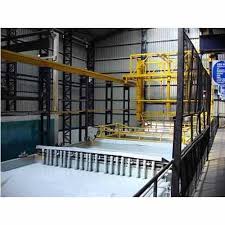
CED process is industrially used for applying coatings to metal fabricated products. It has been widely used to coat automobile bodies and parts, tractors and heavy equipment, electrical switch gear, appliances, metal furniture, beverage containers, fasteners, and many other industrial products.
The first patent for a cathodic ED product was issued in 1965 and assigned to BASF AG. PPG Industries, Inc. was the first to introduce commercially cathodic EPD in 1970. The first cathodic EPD use in the automotive industry was in 1975. Today, around 70% of the volume of EPD in use in the world today is the cathodic EPD type, largely due to the high usage of the technology in the automotive industry. It is probably the best system ever developed and has resulted in great extension of body life in the automotive industry
In short ED method is one of the most efficient methods for primer coating suitable for large volume production for coating complex form items, or where high corrosion resistant coating is required.
Paint material utilisation is approaching 95 to 99%. Corrosion resistance measured in salt spray is excellent and no other painting method can compete with ED method in primer coating.
For all these reasons ED painting is indispensable technology which all industrialized countries must master.
On the other hand ED painting requires more technically competent operators than other painting methods do and it is sometime seen that a whole investment of ED painting line is abandoned after a trouble infested operation continued many months unsuccessfully and finally the owner changes to other methods.
Strong points of ED methods
Suitable for coating form / shape articles.
Excellent edge covering
Utilisation of coating material is more than 95%
Environmentally friendly. Along with powder coating, the method is one of a few technologies to meet VOC emission standards.
Economically for large volume coating.
Powder Coating Line
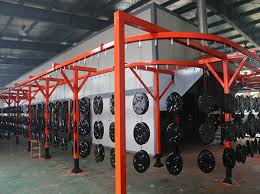
Powder coating is a type of coating that is applied as a free-flowing, dry powder. The main difference between a conventional liquid paint and a powder coating is that the powder coating does not require a solvent to keep the binder and filler parts in a liquid suspension form. The coating is typically applied electrostatically and is then cured under heat to allow it to flow and form a "skin". The powder may be a thermoplastic or a thermoset polymer. It is usually used to create a hard finish that is tougher than conventional paint. Powder coating is mainly used for coating of metals, such as household appliances, aluminium extrusions, drum hardware, and automobile and bicycle parts.
Because powder coating does not have a liquid carrier, it can produce thicker coatings than conventional liquid coatings without running or sagging, and powder coating produces minimal appearance differences between horizontally coated surfaces and vertically coated surfaces. Because no carrier fluid evaporates away, the coating process emits few volatile organic compounds (VOC). Finally, several powder colors can be applied before curing them all together, allowing color blending and bleed special effects in a single layer.
Most powder coatings have a particle size in the range of 30 to 50 μm, a softening temperature Tg around 80°C, a melting temperature around 150°C, and are cured at around 200°C. For such powder coatings, film build-ups of greater than 50 μm may be required to obtain an acceptably smooth film. The surface texture which is considered desirable or acceptable depends on the end product.
Powder Coating application process
Cleaning
Water Dry Off
Coating / application
Curing
Liquid Painting Line
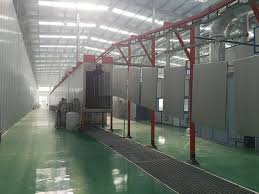
Liquid paint can be applied in many different ways. The three major components of a paint line are pretreatment, application, and cure. The type of industrial application process will be determined by the product, the volume, the quality requirements, and other factors. It may be as simple as a dip tank and a method of hanging parts, or it may be a fully enclosed automated system that allows continuous pretreatment, application, and curing.
The actual layout and specific equipment vary widely, but all paint lines have the same general stages: a loading area, pretreatment or cleaning stage, application stage, curing stage, and unloading area.
The loading/unloading stages are where parts are put on and taken off the paint line. The pretreatment stage is where the parts are prepared for the coating application stage. Cleaning can be done mechanically, such as blasting, or chemically by solvent washing, solvent wiping, power washing, or dipping. After cleaning, the parts are dried by heat or forced air or a combination of the two so that they are ready to be painted.
Paint can be applied by spray method using conventional handheld spray guns, high-volume-low-pressure (HVLP) guns, automatic guns, automatic rotary bells, or discs. The spray equipment can be either nonelectrostatic or electrostatic. Dip systems, flow coaters, curtain coating, or roll coating are other application methods. The curing stage is where the paint film is formed. Paints can be cured by air drying or heating. Ovens for heating are conventional gas-fired, high air velocity gasfired, electric, infra red, UV energy, electron beam, or induction. The ovens can be either batch type or continuous. Parts are moved from one stage to another by manual or automated conveyor systems.
Paint can be applied to a substrate in many different ways. Each method has advantages and limitations. The needs of the product and the manufacturing process will help determine the correct application method. An understanding of the different application processes is necessary in order to evaluate them for a specific task. Most industrial paint systems apply liquid coatings with spray equipment. The liquid coating is delivered from a container to a spray device that uses pressure to break the liquid stream into fine droplets. The even distribution of the liquid paint into a finely divided mist of droplets is called atomization. There are several different types of spray guns and different methods of atomization and pattern control that can be used to control quality and efficiency.
A liquid spray booth is an enclosure around the spray operation that provides containment of the oversprayed paint and controls the spray environment. The spray booth includes an exhaust fan to create negative air pressure inside the booth. The exhaust air contains the overspray, directs paint solids to the filters, and directs the solvent vapors to atmosphere or an abatement system. The booth provides a clean and safe environment for the operator and smooth airflow to enhance paint transfer efficiency. For liquid spray systems, the airflow can be either vertical in a down draft design or horizontal in a cross draft design. Airflow is necessary to contain the paint overspray by creating a slight negative pressure inside the spray booth.
Fbe Coating Line
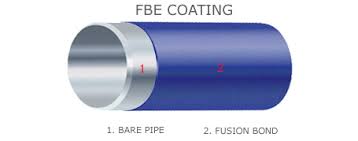
Fusion bonded epoxy coating which was introduced as a protective coating in early 1960s, also known as fusion-bond epoxy powder coating and commonly referred to as FBE coating, is an epoxy-based powder coating that is widely used to protect steel pipe used in pipeline construction, concrete reinforcing bars (rebar) and on a wide variety of piping connections, valves etc. from corrosion. FBE coatings are thermoset polymer coatings. They come under the category of protective coatings in paints and coating nomenclature. The name fusion-bond epoxy is due to resin cross-linking and the application method, which is different from a conventional paint. The resin and hardener components in the dry powder FBE stock remain unreacted at normal storage conditions. At typical coating application temperatures, usually in the range of 180 to 250 °C (356 to 482 °F), the contents of the powder melt and transform to a liquid form. The liquid FBE film wets and flows onto the steel surface on which it is applied, and soon becomes a solid coating by chemical cross-linking, assisted by heat. This process is known as “fusion bonding”. The chemical cross-linking reaction taking place in this case is irreversible. Once the curing takes place, the coating cannot be returned to its original form by any means. Application of further heating will not “melt” the coating and thus it is known as a “thermoset” coating. The world's leading FBE manufacturers are Valspar, SolEpoxy (former Henkel/Dexter), KCC Corporation, Jotun Powder Coatings, Sherwin-Williams, 3M, Axalta, Akzo Nobel, BASF and Rohm & Haas.
FBE coating application process
Regardless of the shape and type of steel surface to be coated, the FBE powder coating application has following essential stages:
Cleaning
Pre-Heating to the recommended FBE powder application temperature
Coating / application
Post Curing
Aquence Coating Line
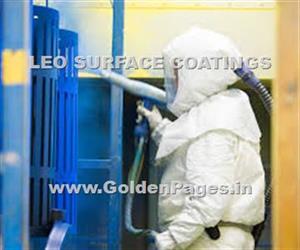
Autodeposition is a waterborn process which depends on chemical reaction to achieve deposition. Henkel with its American daughter company “Parker Amchem” who invented this technology, decided to set up an European coating business group to market Autodeposition technology in Europe in 1992. This technology is also known by its brand name Aquence® which was formerly known as Autophoretic.
This first few plants for Europe were installed in 1995, since its inception, this unique process has been employed to coat over one million square meter of surface. There are numerous installation in operation, coating variety of fabricated steel parts for automotive and general industry market.
The first few for Europe were installed in 1995 & another 11 plants were installed in 1996.
In Aquence® electricity is not required. In this process the “Green” film is rinsed in a special “reaction rinse solution” and subsequently, cured to produce an exceptionally hard film. The unique feature of the autodeposition process is the formation of a very uniform film over the entire surface of the work piece, even in difficult to reach areas. This allows the coating dispersion to flow into and around the most complex shapes.
Principle of Autodeposition
Autodeposition is defined on the controlled deposition of neutral or negatively charged organic particles on the work piece via a chemical reaction. The work piece is positively charged due to positively charged ions originating from the metal surface. This effect is known as Autophoresis.
Autodeposition bath consists of pigmented emulsion polymer dispersed in water. The bath solids vary between 3% to 5% by volume and 4.5% to 6.5% by weight. Bath viscosity is closed to water. The pH of the bath is acidic between 2.0 - 3.0.
Shower Test Facility
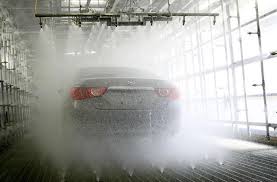
Shower Testing is standard prescribes the procedure for conducting waterproofing test on all automotive vehicles with enclosed compartments for carriage of passenger/ goods, by creating test conditions similar to those in rainy seasons to which an automotive vehicle is likely to be exposed to.
We can design this facility as per different standards which varies as per tropical conditions. For Installation inside India, we design Shower Testers are per IS Standards i.e. " IS 11865". This shower facility is set up to make an artificial shower on the test vehicle. It consist of a concrete floor with adequate facility to drain-out the water. Over this floor a super structure of pipe network is built. The super structure is of adequate height, width and length to accomtnodate the test vehicle underneath it. The size of superstructure is designed considering a clearance of 0.3.to.1 m all around the vehicle. The superstructure is fitted with spray nozzles on top, and both sides. The nozzles used are of full cone and solid type having a spray angle of 60° and capable of square spray pattern for maximum surface coverage .The pitch of these nozzles is 400 mm in both the directions. The flowrate per nozzle is 15 lpm + 15 percent and the water pressure at the nozzle is 200 kPa + 15 percent.
Test Procedure
The test vehicle shall be placed stationary inside shower tester and shall be subjected to the artificial shower. The engine shall be kept idling, wipers in action and head lights on. Water entry inside the vehicle shall be observed and shall be recorded. Water entry inside the engine compartment, luggage comparttnent and in the electrical fittings like head lamps, fog lamps, indicatorlamps, side marker lamps, etc, shall also be recorded.
High Pressure Water Jet
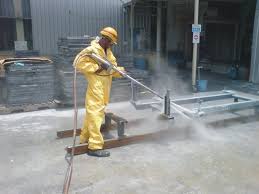
The benefit of water blasting is becoming more recognized all over the world we have gone through a rapid growth over the years leading to an aggressive expansion plan. We are poised to be one of the reputed dealers in India who sells the best machines.
Hydro Blasting, commonly known as water blasting, is a widespread abrasive water discharge operation. As such, it is very successful because of its powerful Hydro Blasting effect. In most cases, because of its efficiency, hydro blasting machine will require only one operator for a given application. Pressure and Flow both play key roles in an efficient high pressure Hydro Blasting Equipment, and applications respond differently to each variable. Typically, hardened deposits respond better to higher pressures, and softer materials are best removed with higher flows. Each application is unique, though, and we can help you determine which combination of pressure and flow will work best for you.
We offer a wide range of water blasting equipment ranging from 110 Bar to 2500 Bar catered for different industries such as Marine, Building and construction, Oil & Gas, Automotive, Power Plants and many other Industries.
The equipment is not only to clean surfaces but also to blast off scales, grime, rust, graffiti and even cut through concrete.
Combo Booth And Painting Cum Drying Chamber
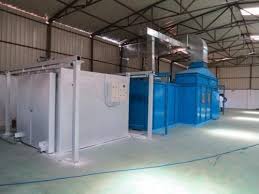
Painting Cycle
Opening entry door in Paint booth.
Pulling the Compenent inside till a pre-specified Location is reached.
Closing of component entry & Exit door. - The painting cycle does not start if the door’s are not closed fully.
Operator “Starts “painting cycle by pressing Painting Cycle Start Button & enters into booth through the operator entry doors provided in the equipment.
After pressing cycle start button, all fresh air supply & exhaust blowers will come ON. Also automatic pneumatic dampers at fresh air intake & exhaust side will get 100% open. During this cycle the Hot air recirculation air damper will always remain closed.
Operators will start painting.
After completion of painting, operators will come out of operator door along with the applicators & Feeding system & stop painting cycle.
Purging Cycle
The Operator will start the Purging cycle, wherein the Painted part will be left inside the paint booth with only the Fresh Air & Exhaust blower on for about 5 to 10 minutes (Settable time) to purge out all the Solvents.
Drying Cycle
Operator will “start” drying cycle by selecting drying cycle button.
After pressing cycle start button in ON, first of all system will ensure that all doors are in closed condition, else it will give the fault signal (in case any one of the single door remains open).
If there is no fault, system will adjust the Solvent exhaust dampers to preset opening % position & Close the exhaust blowers completely. Whereas the Hot air re-circulation blowers through the Fresh air blower will be 100 % in Open position along with the burner.
In drying cycle, automatic pneumatically operated dampers provided at fresh air intake will remain open only for 10 ~ 15%, thereby allowing the dilution air to come in continuously. The damper provided for the Hot air recirculation opens 100 %.
After predefined time (Adjustable from 0 to 60 min) system will give Audio signal & stops drying cycle.
In this way drying cycle will be completed. Now, the option is available with the operator to either let the system go into the Cooling cycle or abort it.
Cooling Cycle
After completion of drying cycle, operator will start cooling cycle.
In cooling cycle both fresh air & exhaust blower will start.
In this cycle Pneumatic dampers at fresh air intake & exhaust side will remains 100% open & hot air recirculation damper will be closed.
After predefined (Adjustable) time the system will give audio signal & stop the cooling cycle.
Our Vision
* To embrace new technologies and methods. * To give unsurpassed products and services to the clients. * To constantly look for improvement and changes.










